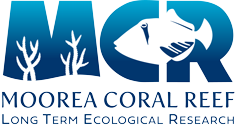Year:
2016
Authors:
Source:
M.S. Thesis
Abstract:
The oceans have absorbed excess carbon dioxide (CO2) resulting from anthropogenic activities such as the burning of fossil fuels and deforestation. As a result, seawater chemistry has shifted causing an increase in bicarbonate ions (HCO32-) and hydrogen ions (H+) and leading to a reduction in carbonate (CO32-) concentration. This shift in seawater chemistry leads to a decrease in aragonite saturation state and pH. Eventually, the ocean will accumulate most of the extra CO2 produced over many years resulting in extreme acidified conditions where aragonite saturation levels will not support the chemical process of calcification that is vital to marine calcifiers. This thesis investigates the combined effects of elevated pCO2 with temperature and light on the calcification and photosynthesis of the green calcareous algae Halimeda. Halimeda, is a major contributor to sediment production for coral reef accretion and island reef formation. Based on carbonate data from biologists and geologists it is estimated that vertical accretion of CaCO3 by Halimeda ranges between 0.18 to 5.9 m in 1000 years. The role that light plays in the coupling between photosynthesis and calcification in Halimeda macroloba was investigated experimentally through a combination of two pCO2 levels (360 and 1200 uatm) and three irradiances (80, 150, and 595 μmol quanta m-2 s-1). A decrease in calcification at low light intensity and elevated pCO2 suggests that light is a limiting factor for the physiology of H. macroloba. The effects of elevated pCO2 and temperature on the photosynthesis and calcification of Halimeda incrassata were tested through two experiments using two pCO2 levels (390 and 900 uatm) and four temperatures (26, 29, 30 and 34 °C). Elevated temperature can mitigate the effects Ocean Acidification (OA) in H. incrassata. An estimate of current carbonate production by H. incrassata in Key Biscayne Florida Lagoon was obtained from biomass, CaCO3 content and turnover rate. Calcification rates from laboratory experiments were used to estimate future (200 years from now) seasonal carbonate production rates, which were then compared against current summer carbonate production. Future summer carbonate production rates were not affected by elevated pCO2 in relationship to current summer carbonate production. Elevated temperatures ~2 °C above summer maximum average could promote calcification of H. incrassata under ocean acidification conditions and, therefore, overall carbonate production of the reef. Results throughout the thesis revealed that the tolerance of the green calcareous algae Halimeda to OA could change depending on light and temperature conditions. In a more acidic future ocean, growth rates and sediment production of Halimeda will be affected under low light and temperature and will be enhanced under high light and and moderate elevated temperatures.
Pages:
124 Pp.
Publication Type:
Thesis or Dissertation
Publisher:
Department of Biology, CSU Northridge



